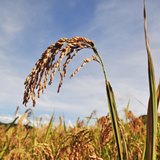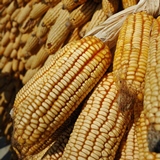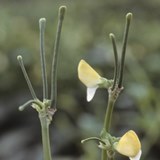Final external review – how did we fare?
- Published Date
 The report of our final external review has been published. The review’s aim was to determine to what extent GCP has supported genomic research and molecular plant breeding for developing-country partners. In addition, as GCP represented a new business model for international agricultural research in CGIAR – the Challenge Programmes (CPs) – the review also examined whether the CP model has indeed been useful, and to what extent particular aspects of it might be replicated in the current CGIAR Research Programmes (CRPs). The idea was to learn from one of the first multi-Centre multi-partner CGIAR programmes that were the predecessors of the current CRPs.
The report of our final external review has been published. The review’s aim was to determine to what extent GCP has supported genomic research and molecular plant breeding for developing-country partners. In addition, as GCP represented a new business model for international agricultural research in CGIAR – the Challenge Programmes (CPs) – the review also examined whether the CP model has indeed been useful, and to what extent particular aspects of it might be replicated in the current CGIAR Research Programmes (CRPs). The idea was to learn from one of the first multi-Centre multi-partner CGIAR programmes that were the predecessors of the current CRPs.
Previously, GCP has undergone several reviews. This final external review of was at the request of GCP’s management and Executive Board, with the consent of the GCP Consortium Committee. It was implemented by the CGIAR Independent Evaluation Arrangement (IEA). The review was undertaken in late 2013, and therefore about a year before GCP’s closure. The review report published in April 2014 made 11 recommendations, all of which GCP agreed with.
The review included two surveys – one on Programme evaluation administered to stakeholders and grant recipients, and another on governance and management administered to a smaller select audience, conversant with these aspects through their interaction with GCP. Some of the lessons learnt from GCP would be relevant to CRPs and other similar research initiatives in terms of governance, transparency in operations, mix of competitive and commissioned projects, and the crucial role of strategic capacity building (CB) to meaningfully and sustainably empower developing-country partners, by fully integrating CB into core research.
The review rated GCP as follows:
- highly satisfactory for relevance, research effectiveness, impact and sustainability, quality of science, and governance and management; and,
- satisfactory for research efficiency.
The report’s conclusion stated that: "The Review Team established that GCP has performed well, has met the majority of its genetic enhancement goals and surpassed others, and will leave a formidable legacy of useful and accessible products and information.”
Previous external reviews have underscored that effective partnerships have been one, if not the major, achievements of the Programme. The 2008 External Programme and Management Review (EPMR) noted that perhaps GCP’s most important value was “…the opportunities it [GCP] has provided for people of diverse backgrounds to think collectively about solutions to complex problems, and, in the process, to learn from one another.” More recently, this final review stated that GCP’s “research partnerships provide gains that are more than the sum of their parts…[with]… synergies and benefits that appear to have enduring value.” A key lesson is that a partnership initiative requires specific management structures and financial resources to be successful: it does not occur spontaneously on its own.
This afternoon, the GCP Director, Jean-Marcel Ribaut, will be presenting part of the report to members of the CGIAR Fund Council who are visiting our Host Centre, CIMMYT. Jean-Marcel’s presentation will mainly focus on lessons learnt, and their relevance for CRPs. Earlier in March this year, he’d made a presentation at a meeting of the CGIAR Independent Science and Partnership Council, focusing mainly on the results of the two surveys above. Our thanks to all who responded to the surveys, which were a core part of the review.
The final review report and the terms of reference for the Review Panel, as well as reports for all previous reviews, are on our Reviews and evaluations page. If you're interested in more of GCP's history, and a candid view of what the Programme looked like as twilight approached and the lessons learnt at the time, see this 2012 blogpost.
Serious cereal addiction: blogposts on maize and rice research hit the spot
- Published Date
Now our blog spotlight swings to some of what’s happening in cereal research at GCP, with a closer look at the science side of two profiles recently featured in the International Women’s Day media extravaganza.
 |
| Waving farewell to rice... ...and a warm welcome for maize from Rebecca Nelson |
 |
Serial cereal scientist connects rice and maize crossing continents
Introducing Rebecca Nelson (Cornell University, USA), whose research career took her from across the Americas to Asia and back again, with regular stops in Africa along the way. She also switched cereals during that time, from rice to maize, with GCP laying the cement in the middle. Says Rebecca: “We were really grateful that GCP funded us so we could continue to understand and build resistance to rice blast and bacterial blight, and to connect the work on rice and maize.”
GCP was involved in a few crucial collaborations for Rebecca, as she joined forces for rice with Hei Leung (International Rice Research Institute – IRRI, then also GCP’s Genomics Subprogramme Leader), and for maize with James Gethi (Kenya Agricultural Research Institute – KARI, currently on sabbatical at CIMMYT). She also helped establish fellow GCP researcher Masdiar Bustamam’s molecular-breeding laboratory at the Indonesian Center for Agricultural Biotechnology and Genetic Resources Research and Development (ICABIOGRAD). Today, Rebecca oversees her own laboratory at Cornell and is also a scientific director for one of the McKnight Foundation’s grant programmes. More
 |
| The looming clouds of climate change forecast flash floods and rising seas: double trouble for rice |
Rice researcher with singular vision delivers double
Our next post is on rice researcher, Armin Bhuiya, who is firmly a one-cereal scientist, though her research has seen her doubling up on traits, by studying both salt and submergence tolerance – in both her native Bangladesh, and at IRRI in the Philippines. For Armin, it seems that ‘two is the magic number’, as this pattern of duality has continued throughout her research career, as we shall see. First, she arrived at her research topic by consulting with farmers and fellow scientists, as both tides and flash floods affect rice crops in South and Southeast Asia, so that inland and coastal areas could both benefit from her work. As if that wasn’t already enough ‘twosomes’, the couples continue: during her PhD programme (jointly funded by GCP and DuPont Pioneer), she successfully combined conventional and molecular breeding, conducting research with two different mapping populations. To cap it all, she is now both student and teacher back home in Bangladesh, where she is continuing her studies and teaching modern molecular plant-breeding methods to students and colleagues alike. More
Our next blogposts in the continuing cereal series will bring in more cereals, a few more women scientists, not forgetting our many men scientists. Watch this space!
In the meantime, here are more profiles of our researchers.
Cowpea research – the leaders and the science
- Published Date
Our recent cowpea blogposts have it all: adventure, drama…romance, even, as we share with you a legume love affair second to none. Sample this…
Breaking barricades and a personal passion: cowpeas tap into genomics revolution

Passion blooms bright: cowpea flower in the field
First, travel with us through the mists of time to unravel how cowpeas came to be part of GCP’s Tropical Legumes I (TLI) Project back in 2007, with the original avant gardener himself, Jeff Ehlers (now with the Bill & Melinda Gates Foundation). Jeff constantly honed the cutting edge of cowpea research as the genomics revolution dawned. In this golden-green blogpost, we are California Dreamin’ with Jeff as we learn how his green-fingered grassroots grew deep and strong to catapult the lowly cowpea to the court of crop-breeding elites, as he and his former team at the University of California–Riverside (UCR), USA, brought the former ‘orphan’ crop in from the cold. Jeff commends the collaborative model employed by GCP, celebrates the nurturing power of community spirit, emphasises the importance of capacity building, and looks to the future of crop research with GCP’s Integrated Breeding Platform (IBP) offering tools and training on modern breeding. More
From laid back to standing tall

Cowpea flower pods standing tall
Our next blogpost focuses on cowpeas’ very character, with Phil Roberts (UCR) taking up the mantle of cowpea connoisseur from Jeff Ehlers as TLI cowpea research leader.
Unlike some legumes known for their questionable manners and ‘difficult’ personalities (but we shall name no names!), cowpeas are etiquette personified, characterised as easy-going, adaptable and popular – they’re the most important grain legume in sub-Saharan Africa for subsistence and cash. Unfortunately, cowpeas are so laid back, they’re almost lying down: they are easy prey for pests and disease, depressing yields to unacceptable lows.
Enter Phil and team, to shake the metaphoric shoulders of this laidback legume with modern breeding. In Phil’s own words, with molecular methods, “It’s a lot easier and quicker, and certainly less hit-or-miss than traditional methods!” More
Call to the wild: groundnuts collect on kinship from ‘country cousins’
- Published Date
In a brand-new blogpost, Vincent Vadez of the International Crops Research Institute for the Semi-Arid Tropics (ICRISAT), and our research leader for groundnuts in the Legumes Research Initiative, walks us through the pitfalls and pedestals groundnuts are wont to fall and rise to, making the crop something of a research rollercoaster ride! The lows for this legume include poor yield, and a predisposition to diseases, drought and pests. Add to this a complex genetic structure, narrow genetic diversity and a reputation for slow and difficult breeding, and you have one complicated crop!
 |
| Groundnut flowers. Bright country cousins have the right stuff! |
Vincent goes on to explain that this is where family comes in useful, with groundnuts’ sturdy wild relatives lending a helpful gene or two to fortify their cultivated ‘city cousin’ (despite a few family feuds along the way). Mix in maps, models, and molecular breeding, which are some of the milestones along the motorway to success.
Switching gears from the crop to people, family is also the key to success with the groundnut research family stretching from ICRISAT to Africa (Malawi, Senegal and Tanzania), and beyond to the Brazilian Agricultural Research Corporation (EMBRAPA), France’s Centre de coopération internationale en recherche agronomique pour le développement ‒ CIRAD, and USA’s University of Georgia.
Find out more about why ‘variegated’ partnerships and variety selection are indeed the spice of groundnut research life in the full blogpost.
Links: Groundnut – research | research products | InfoCentre | videos | blogposts
Cassava ready for a close-up after ‘research make-over’ in Ghana
- Published Date
Want to know what’s 'in' in crop science this planting season? Check out our latest blogpost on the very latest in the world of cassava in Ghana, where GCP researcher and cassava style guru, Elizabeth Parkes (Crops Research Institute [CRI] of Ghana’s Council for Scientific and Industrial Research [CSIR], currently on leave of absence at the International Institute of Tropical Agriculture [IITA]), has been at the forefront of a research make-over for cassava.
 |
| Chic shot: cassava leaf up close |
In this post, Elizabeth explains how she was able to deal with the ‘difficult dour diva’ of crop science, enduring its tricky genetics and long-season, labour-intensive habits, and combatting pests and disease, together with a dedicated team of cassava students and researchers under her expert tutelage. Add in some GCP molecular-breeding know-how, infrastructure support and capacity-building initiatives to bloom and grow…for both cassava plants as well as Elizabeth’s human charges! More
We are family: the science sisterhood and cassava capacity building

Cassava leaves cast some stylish shadows
In case you missed it the first time around (as part of our International Women’s Day celebration of sisters in science), here’s another look at an alternative blogpost profiling the life and work of Elizabeth Parkes, chronicling her inauguration into the world of science, and subsequent rise to Lead Researcher for GCP’s cassava work in Ghana. The post also focuses on GCP-funded infrastructure, professional development, uptake of molecular tools by local staff in Ghana, and more. Mix in the invaluable boost of GCP’s Genotyping Support Service (GSS), Communities of Practice (CoPs), and training and use of GCP’s Integrated Breeding Platform to tap a wealth of sequencing data, and you have a cassava breeding team to reckon with! More
 |
| Elizabeth Parkes |
|
Episode 4.1 – Why supporting women matters – and will prove to pay dividends |
Episode 4.2 – Women scientists who are having their (cassava) cake and eating it too, thank you very much! |
|
Episode 4.3 – On the ground: How women farmers with large-scale ambitions are ruling the roost in small-scale agriculture |
Episode 4.4 – Calling all budding crop researchers, particularly women! These are exciting times, especially for cassava! |
|
Episode 4.0 (full episode) – Introducing cassava researcher Elizabeth Parkes – a female force to reckon with! |
|
Links – Cassava: Research Initiative | Products | Community of Practice | InfoCentre | Blogposts


